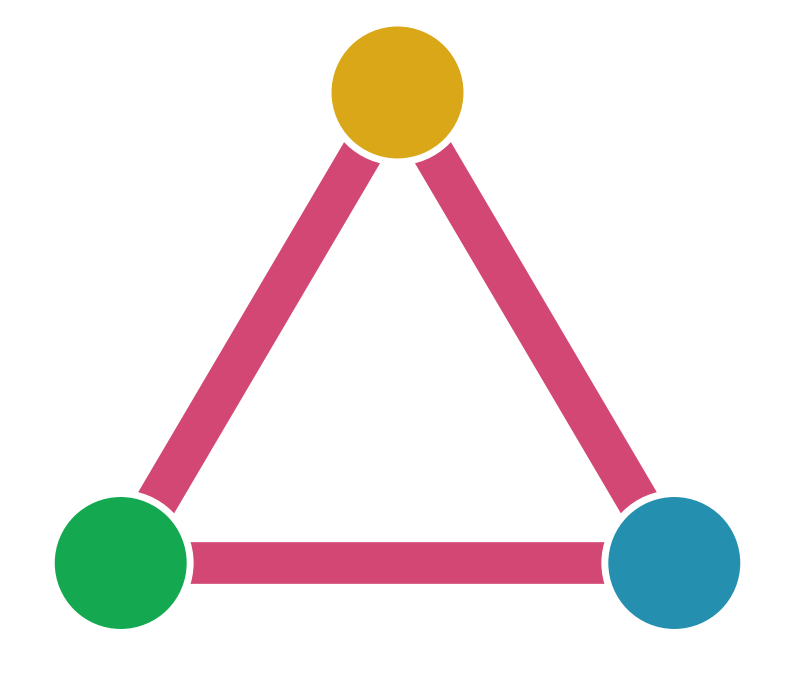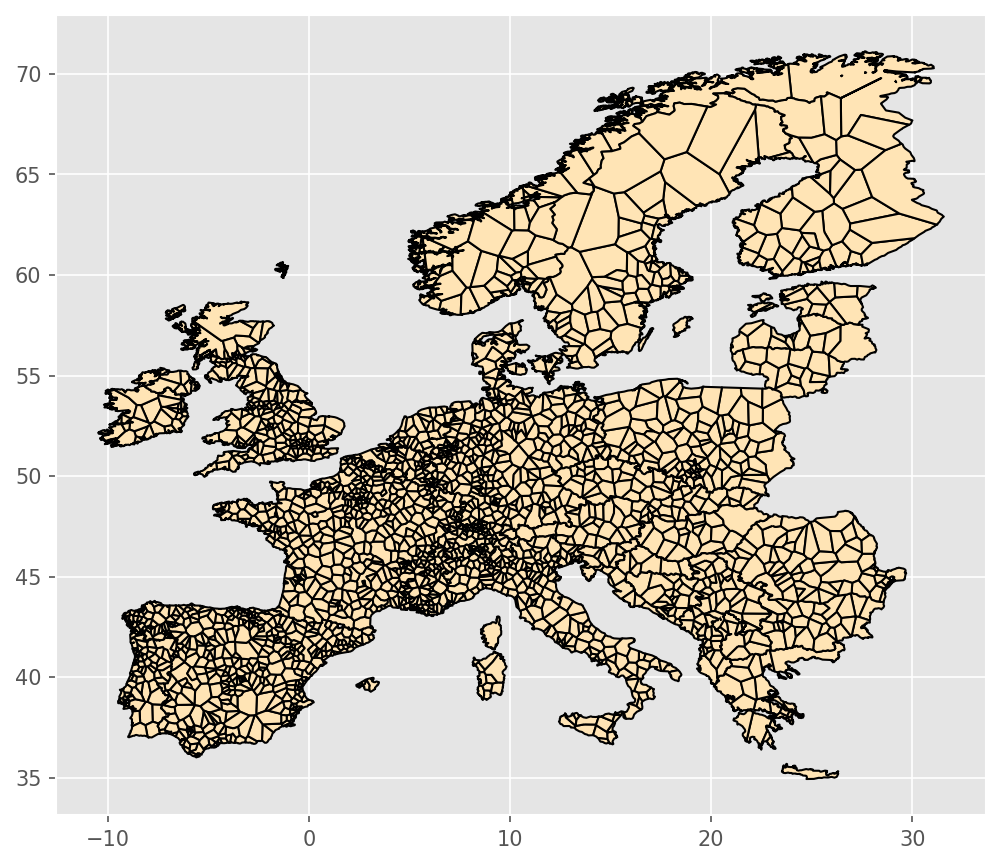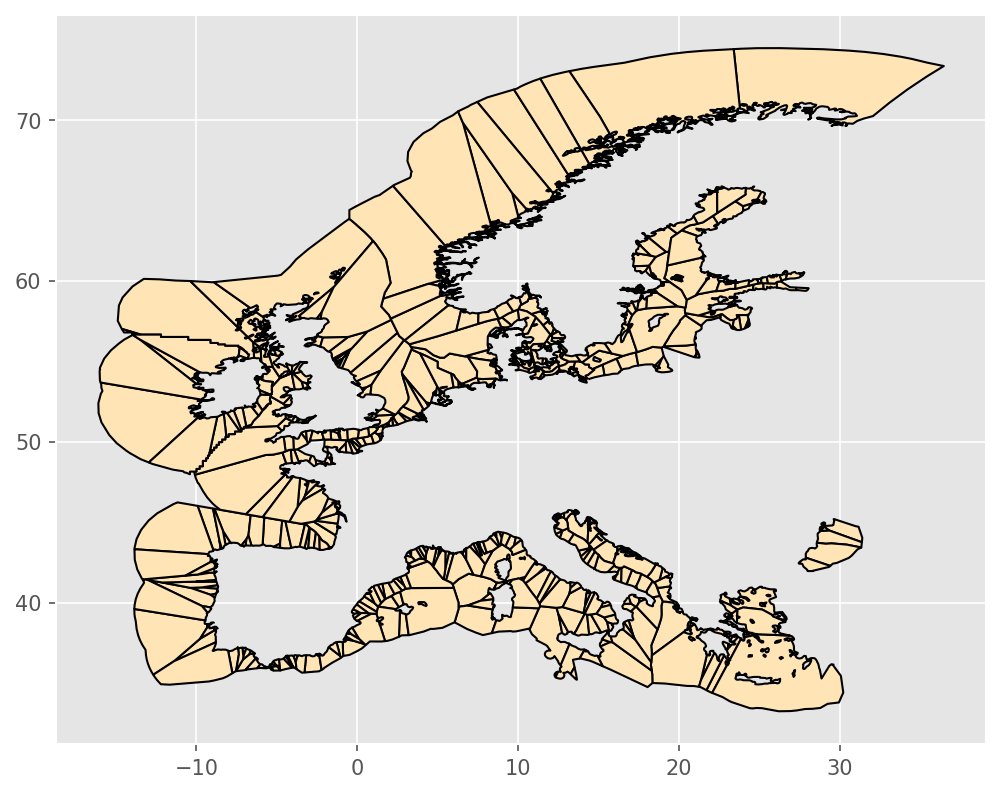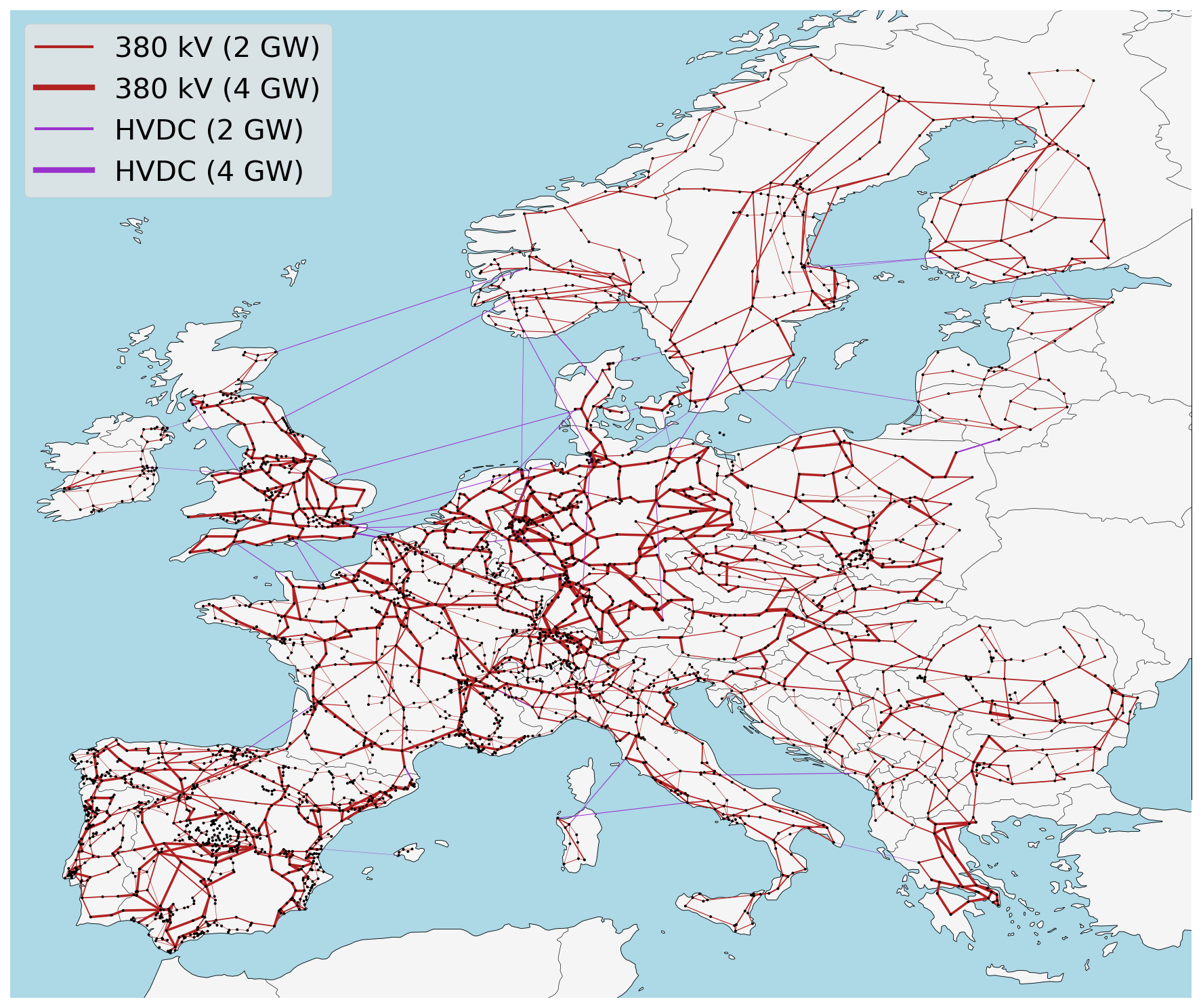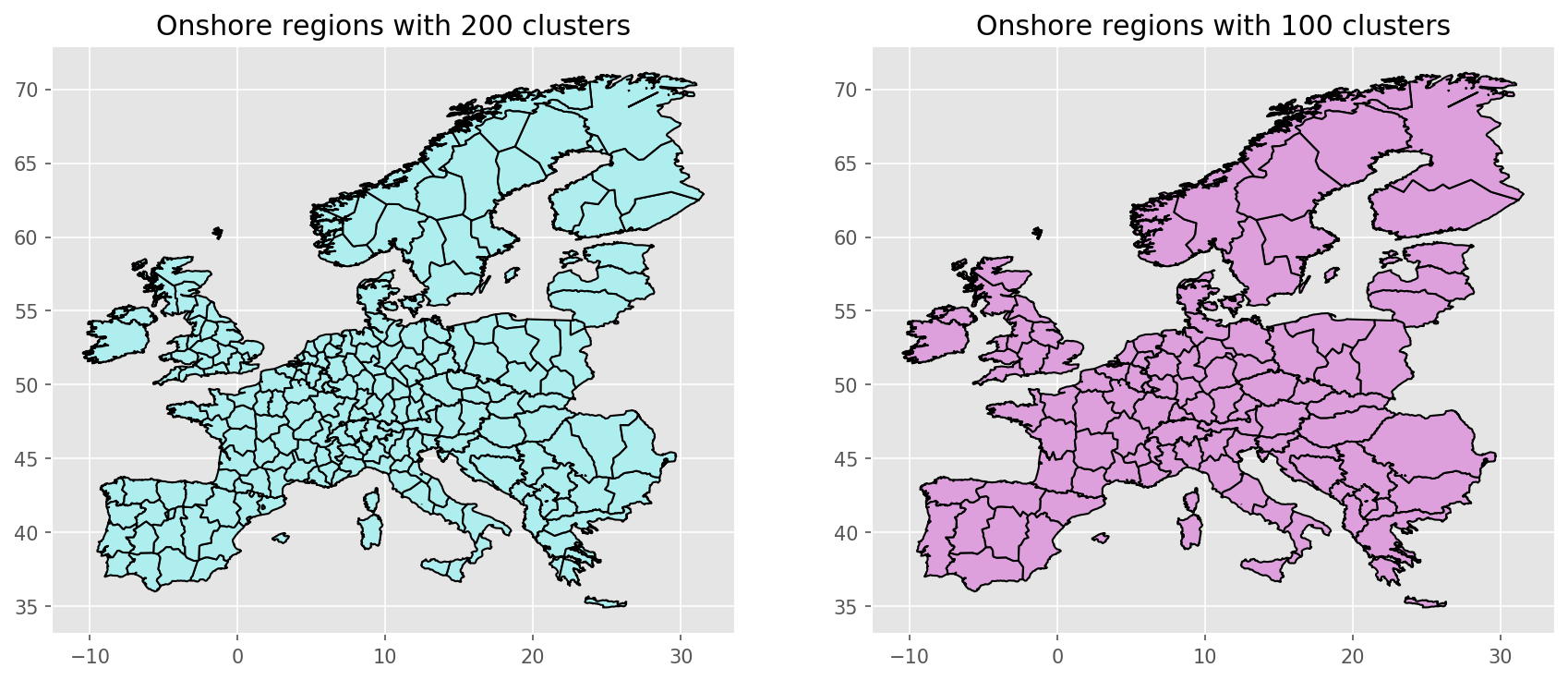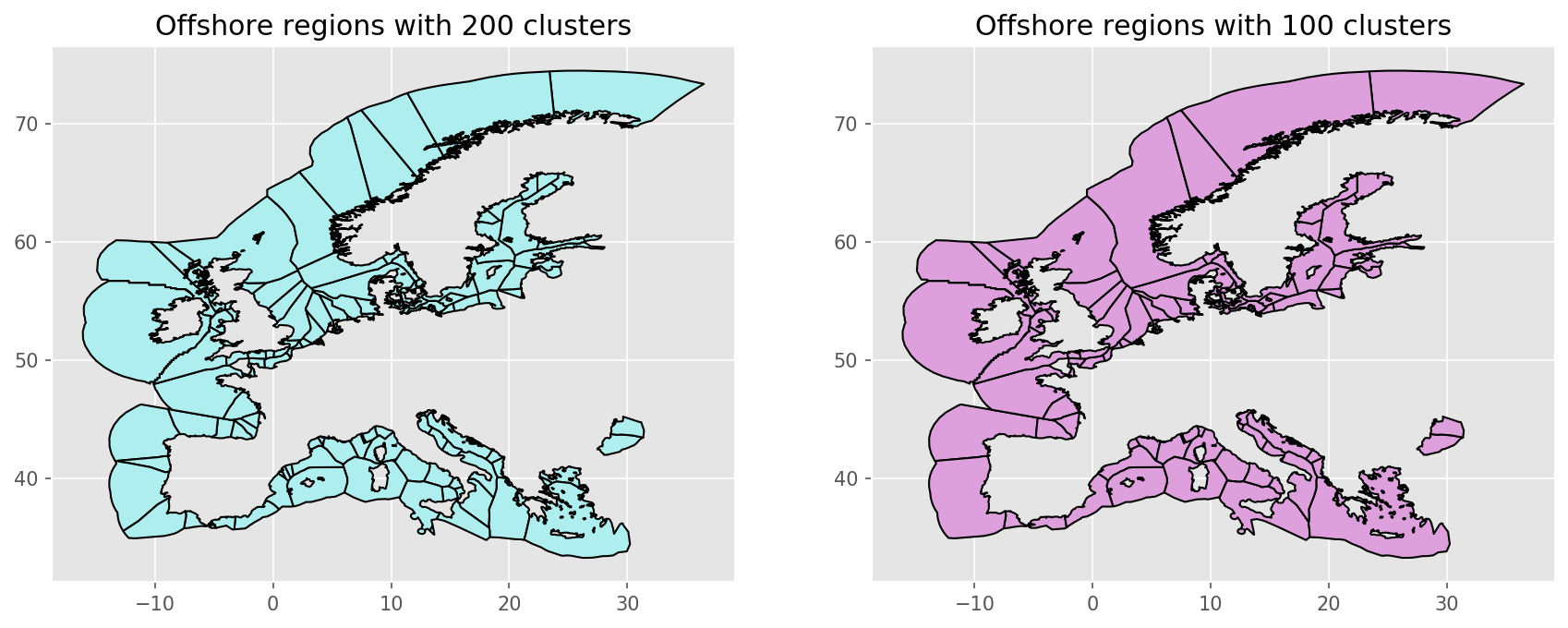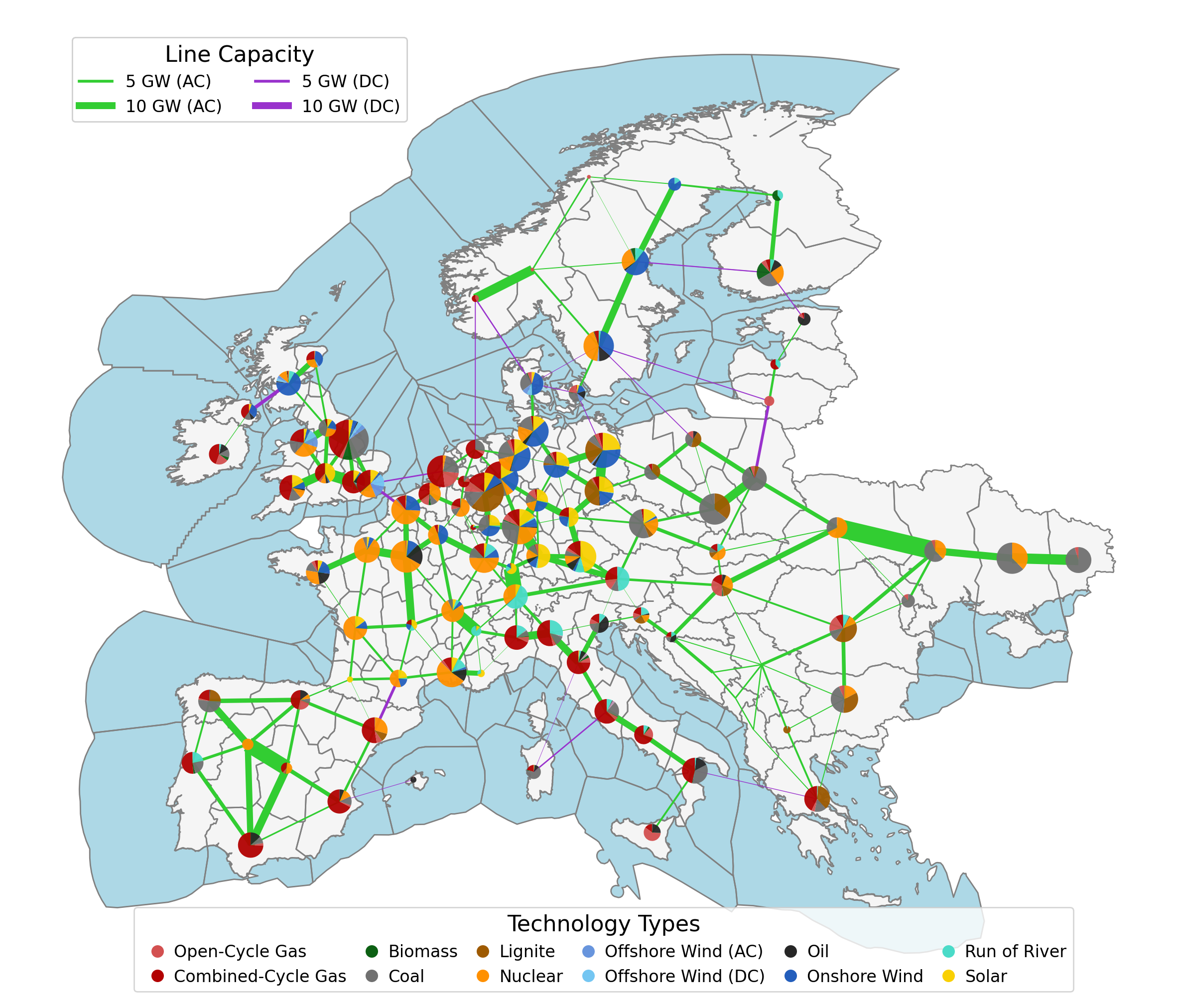Simplifying Electricity Networks#
The simplification snakemake rules prepare approximations of the full model, for which it is computationally viable to co-optimize generation, storage and transmission capacities.
simplify_networktransforms the transmission grid to a 380 kV only equivalent network, whilecluster_networkuses a k-means based clustering technique to partition the network into a given number of zones and then reduce the network to a representation with one bus per zone.
The simplification and clustering steps are described in detail in the paper
Jonas Hörsch and Tom Brown. The role of spatial scale in joint optimisations of generation and transmission for European highly renewable scenarios), 14th International Conference on the European Energy Market, 2017. arXiv:1705.07617, doi:10.1109/EEM.2017.7982024.
After simplification and clustering of the network, additional components may be appended in the rule add_extra_components and the network is prepared for solving in prepare_network.
Rule simplify_network#
Lifts electrical transmission network to a single 380 kV voltage layer, removes dead-ends of the network, and reduces multi-hop HVDC connections to a single link.
Relevant Settings#
clustering:
simplify_network:
cluster_network:
aggregation_strategies:
costs:
year:
version:
fill_values:
marginal_cost:
capital_cost:
electricity:
max_hours:
lines:
length_factor:
links:
p_max_pu:
solving:
solver:
name:
See also
Documentation of the configuration file config/config.yaml at
costs, electricity, renewable,
conventional, links, solving
Inputs#
resources/costs.csv: The database of cost assumptions for all included technologies for specific years from various sources; e.g. discount rate, lifetime, investment (CAPEX), fixed operation and maintenance (FOM), variable operation and maintenance (VOM), fuel costs, efficiency, carbon-dioxide intensity.resources/regions_onshore.geojson: confer Rule build_bus_regionsresources/regions_offshore.geojson: confer Rule build_bus_regionsnetworks/elec.nc: confer Rule add_electricity
Outputs#
resources/regions_onshore_elec_s{simpl}.geojson:resources/regions_offshore_elec_s{simpl}.geojson:resources/busmap_elec_s{simpl}.csv: Mapping of buses fromnetworks/elec.nctonetworks/elec_s{simpl}.nc;networks/elec_s{simpl}.nc:
Description#
The rule simplify_network does up to four things:
Create an equivalent transmission network in which all voltage levels are mapped to the 380 kV level by the function
simplify_network(...).DC only sub-networks that are connected at only two buses to the AC network are reduced to a single representative link in the function
simplify_links(...). The components attached to buses in between are moved to the nearest endpoint. The grid connection cost of offshore wind generators are added to the capital costs of the generator.Stub lines and links, i.e. dead-ends of the network, are sequentially removed from the network in the function
remove_stubs(...). Components are moved along.Optionally, if an integer were provided for the wildcard
{simpl}(e.g.networks/elec_s500.nc), the network is clustered to this number of clusters with the routines from thecluster_networkrule with the functioncluster_network.cluster(...). This step is usually skipped!
Rule cluster_network#
Creates networks clustered to {cluster} number of zones with aggregated
buses, generators and transmission corridors.
Relevant Settings#
clustering:
cluster_network:
aggregation_strategies:
focus_weights:
solving:
solver:
name:
lines:
length_factor:
See also
Documentation of the configuration file config/config.yaml at
Top-level configuration, renewable, solving, conventional
Inputs#
resources/regions_onshore_elec_s{simpl}.geojson: confer Rule simplify_networkresources/regions_offshore_elec_s{simpl}.geojson: confer Rule simplify_networkresources/busmap_elec_s{simpl}.csv: confer Rule simplify_networknetworks/elec_s{simpl}.nc: confer Rule simplify_networkdata/custom_busmap_elec_s{simpl}_{clusters}.csv: optional input
Outputs#
resources/regions_onshore_elec_s{simpl}_{clusters}.geojson:resources/regions_offshore_elec_s{simpl}_{clusters}.geojson:resources/busmap_elec_s{simpl}_{clusters}.csv: Mapping of buses fromnetworks/elec_s{simpl}.nctonetworks/elec_s{simpl}_{clusters}.nc;resources/linemap_elec_s{simpl}_{clusters}.csv: Mapping of lines fromnetworks/elec_s{simpl}.nctonetworks/elec_s{simpl}_{clusters}.nc;networks/elec_s{simpl}_{clusters}.nc:
Description#
Note
Why is clustering used both in simplify_network and cluster_network ?
Consider for example a network
networks/elec_s100_50.ncin whichsimplify_networkclusters the network to 100 buses and in a second stepcluster_network`reduces it down to 50 buses.In preliminary tests, it turns out, that the principal effect of changing spatial resolution is actually only partially due to the transmission network. It is more important to differentiate between wind generators with higher capacity factors from those with lower capacity factors, i.e. to have a higher spatial resolution in the renewable generation than in the number of buses.
The two-step clustering allows to study this effect by looking at networks like
networks/elec_s100_50m.nc. Note the additionalmin the{cluster}wildcard. So in the example network there are still up to 100 different wind generators.In combination these two features allow you to study the spatial resolution of the transmission network separately from the spatial resolution of renewable generators.
Is it possible to run the model without the simplify_network rule?
No, the network clustering methods in the PyPSA module pypsa.clustering.spatial do not work reliably with multiple voltage levels and transformers.
Tip
The rule cluster_networks runs
for all scenario s in the configuration file
the rule cluster_network.
Exemplary unsolved network clustered to 512 nodes:
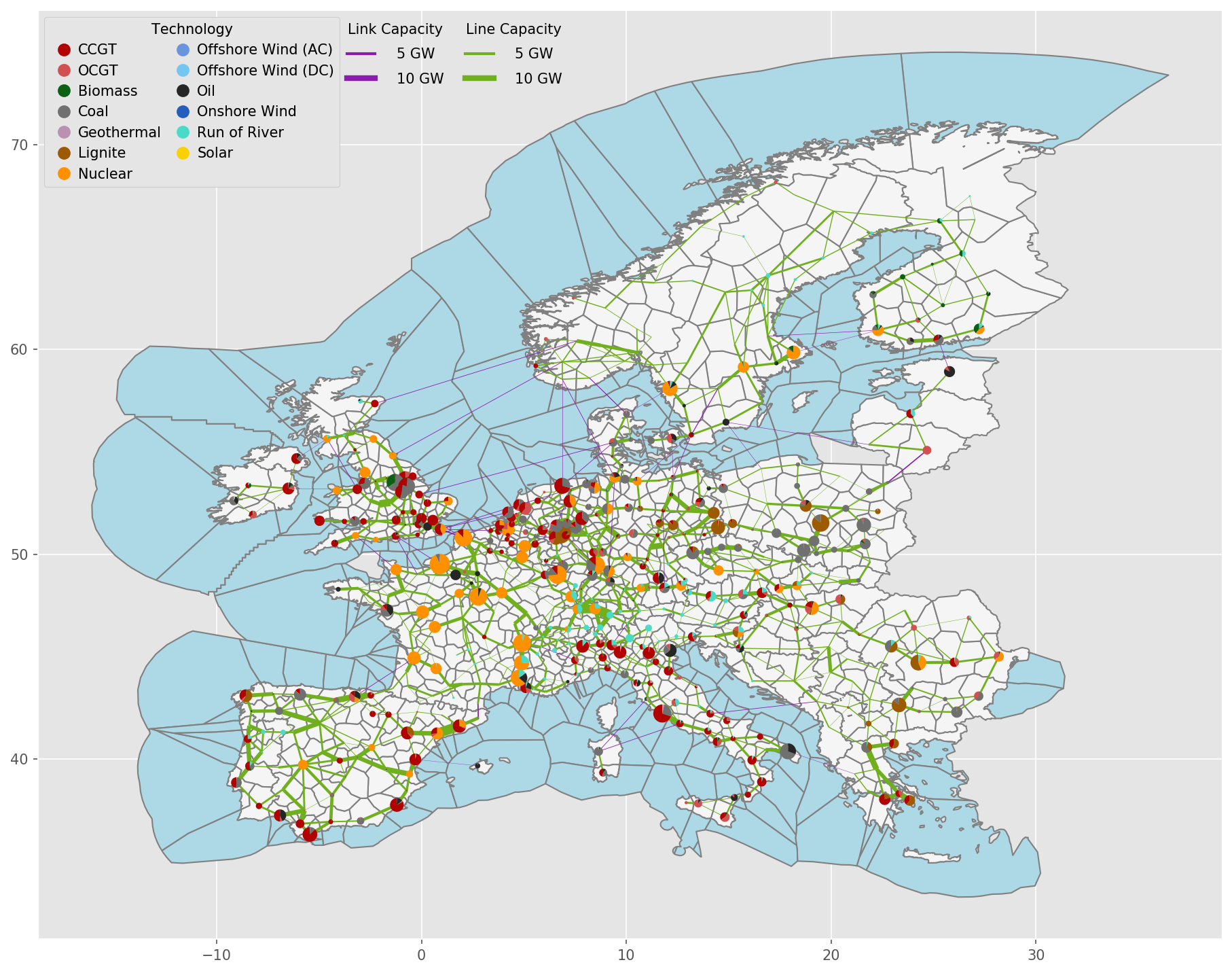
Exemplary unsolved network clustered to 256 nodes:

Exemplary unsolved network clustered to 128 nodes:
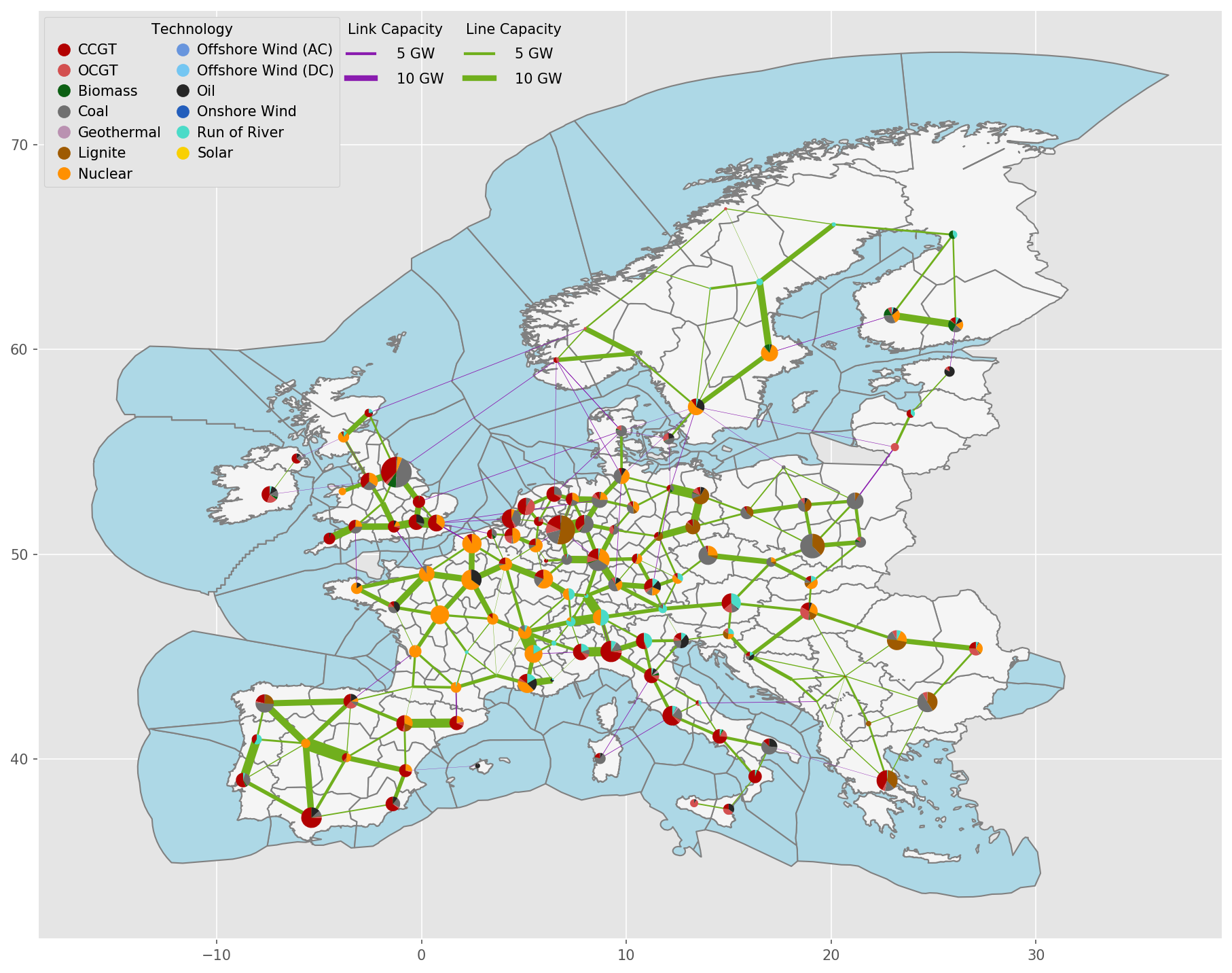
Exemplary unsolved network clustered to 37 nodes:
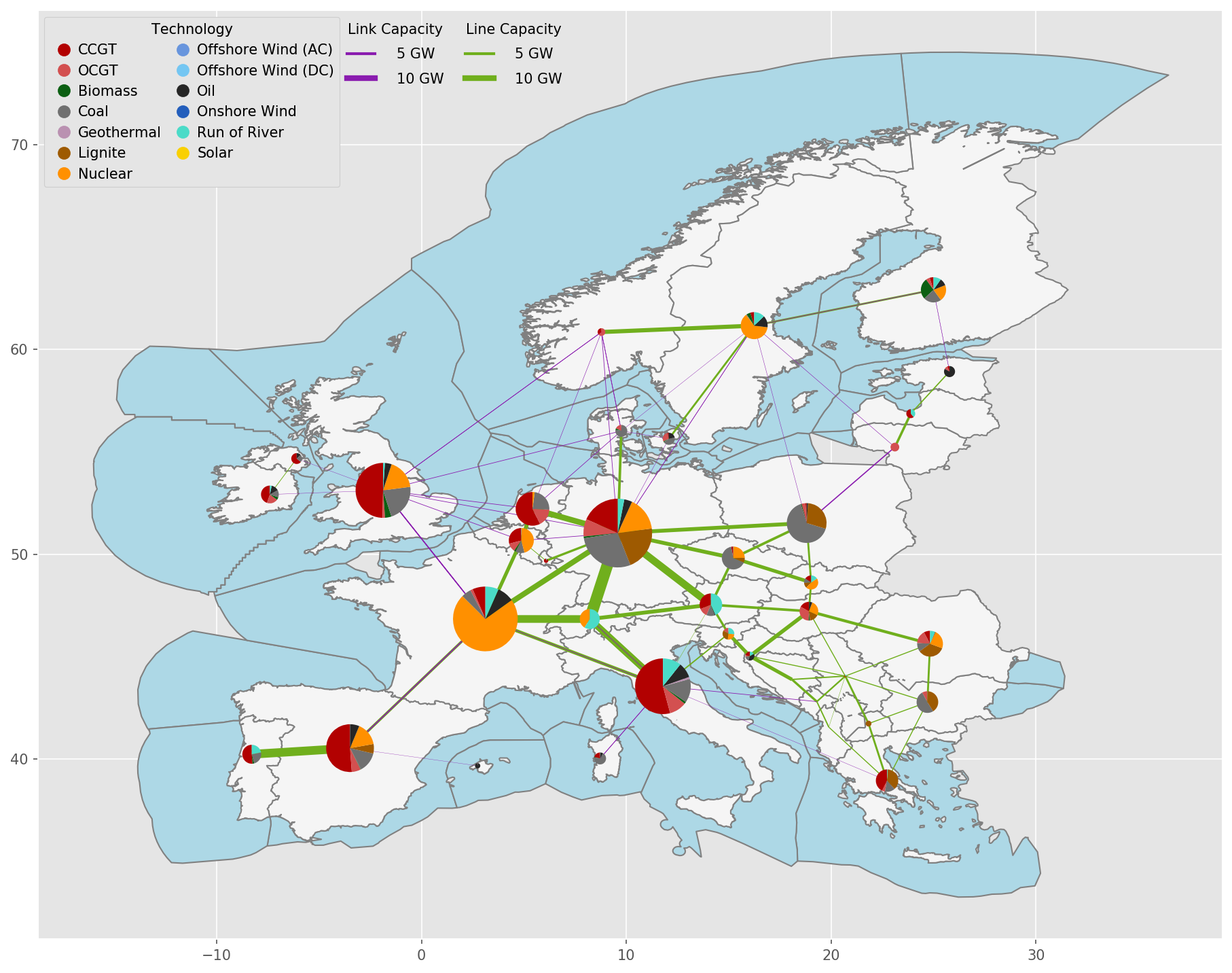
Rule add_extra_components#
Adds extra extendable components to the clustered and simplified network.
Relevant Settings#
costs:
year:
version:
dicountrate:
emission_prices:
electricity:
max_hours:
marginal_cost:
capital_cost:
extendable_carriers:
StorageUnit:
Store:
See also
Documentation of the configuration file config/config.yaml at costs,
electricity
Inputs#
resources/costs.csv: The database of cost assumptions for all included technologies for specific years from various sources; e.g. discount rate, lifetime, investment (CAPEX), fixed operation and maintenance (FOM), variable operation and maintenance (VOM), fuel costs, efficiency, carbon-dioxide intensity.
Outputs#
networks/elec_s{simpl}_{clusters}_ec.nc:
Description#
The rule add_extra_components attaches additional extendable components to the clustered and simplified network. These can be configured in the config/config.yaml at electricity: extendable_carriers:. It processes networks/elec_s{simpl}_{clusters}.nc to build networks/elec_s{simpl}_{clusters}_ec.nc, which in contrast to the former (depending on the configuration) contain with zero initial capacity
StorageUnitsof carrier ‘H2’ and/or ‘battery’. If this option is chosen, every bus is given an extendableStorageUnitof the corresponding carrier. The energy and power capacities are linked through a parameter that specifies the energy capacity as maximum hours at full dispatch power and is configured inelectricity: max_hours:. This linkage leads to one investment variable per storage unit. The defaultmax_hourslead to long-term hydrogen and short-term battery storage units.Storesof carrier ‘H2’ and/or ‘battery’ in combination withLinks. If this option is chosen, the script adds extra buses with corresponding carrier where energyStoresare attached and which are connected to the corresponding power buses via two links, one each for charging and discharging. This leads to three investment variables for the energy capacity, charging and discharging capacity of the storage unit.
Rule prepare_network#
Prepare PyPSA network for solving according to The {opts} wildcard and The {ll} wildcard, such as.
adding an annual limit of carbon-dioxide emissions,
adding an exogenous price per tonne emissions of carbon-dioxide (or other kinds),
setting an N-1 security margin factor for transmission line capacities,
specifying an expansion limit on the cost of transmission expansion,
specifying an expansion limit on the volume of transmission expansion, and
reducing the temporal resolution by averaging over multiple hours or segmenting time series into chunks of varying lengths using
tsam.
Relevant Settings#
costs:
year:
version:
fill_values:
emission_prices:
marginal_cost:
capital_cost:
electricity:
co2limit:
max_hours:
See also
Documentation of the configuration file config/config.yaml at
costs, electricity
Inputs#
resources/costs.csv: The database of cost assumptions for all included technologies for specific years from various sources; e.g. discount rate, lifetime, investment (CAPEX), fixed operation and maintenance (FOM), variable operation and maintenance (VOM), fuel costs, efficiency, carbon-dioxide intensity.networks/elec_s{simpl}_{clusters}.nc: confer Rule cluster_network
Outputs#
networks/elec_s{simpl}_{clusters}_ec_l{ll}_{opts}.nc: Complete PyPSA network that will be handed to thesolve_networkrule.
Description#
Tip
The rule prepare_elec_networks runs
for all scenario s in the configuration file
the rule prepare_network.
